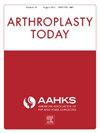Robotic Assistance in Simultaneous Bilateral Medial Unicompartmental Knee Arthroplasty: A Retrospective Cohort Study of 126 Knees Demonstrating Enhanced Radiographic Accuracy and Comparable Safety to Conventional Methods
IF 1.5
Q3 ORTHOPEDICS
引用次数: 0
Abstract
Background
One-stage bilateral unicompartmental knee arthroplasty (BUKA) is a promising option for patients with bilateral medial knee osteoarthritis. This study aims to compare the safety, early clinical and functional outcomes, and radiological results of conventional vs robotic-assisted medial BUKA.
Methods
A retrospective cohort study was conducted involving patients who underwent medial BUKA as a single-stage procedure between April 2016 and January 2022. The study included both conventional (36 procedures) and robotic-assisted techniques (90 procedures) with a minimum follow-up of 6 months. Conventional procedures were performed either simultaneously by two surgical teams or sequentially by one team. Robotic procedures were exclusively performed sequentially by a single team. Data on surgical outcomes, patient-reported outcome measures (International Knee Society score), and radiographic measurements were collected.
Results
Among the 63 patients analyzed, robotic-assisted procedures took significantly longer (115 ± 22 minutes) compared to conventional approaches (86.9 ± 12 minutes; P < .0001). No significant differences were observed in complications, length of hospital stay, rehospitalizations, patient-reported outcome measures, or overall clinical outcomes. However, radiographic analysis showed superior joint line restoration in the robotic group (−0.2 ± 0.7 mm vs −1.4 ± 1.35 mm, P = .03) and better tibial implant varus control (0.3° ± 0.6 vs 1° ± 1.8 degrees, P = .03).
Conclusions
While robotic-assisted BUKA resulted in longer operative times, clinical outcomes were comparable. Radiographic findings indicated improved implant positioning, suggesting potential benefits in implantation accuracy that warrant further research.
Level of Evidence
IV.
求助全文
约1分钟内获得全文
求助全文
来源期刊

Arthroplasty Today
Medicine-Surgery
CiteScore
2.90
自引率
0.00%
发文量
258
审稿时长
40 weeks
期刊介绍:
Arthroplasty Today is a companion journal to the Journal of Arthroplasty. The journal Arthroplasty Today brings together the clinical and scientific foundations for joint replacement of the hip and knee in an open-access, online format. Arthroplasty Today solicits manuscripts of the highest quality from all areas of scientific endeavor that relate to joint replacement or the treatment of its complications, including those dealing with patient outcomes, economic and policy issues, prosthetic design, biomechanics, biomaterials, and biologic response to arthroplasty. The journal focuses on case reports. It is the purpose of Arthroplasty Today to present material to practicing orthopaedic surgeons that will keep them abreast of developments in the field, prove useful in the care of patients, and aid in understanding the scientific foundation of this subspecialty area of joint replacement. The international members of the Editorial Board provide a worldwide perspective for the journal''s area of interest. Their participation ensures that each issue of Arthroplasty Today provides the reader with timely, peer-reviewed articles of the highest quality.
 求助内容:
求助内容: 应助结果提醒方式:
应助结果提醒方式:


